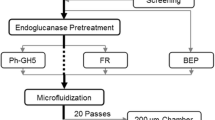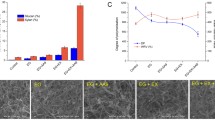Abstract
A newly identified cellulase with a high polysaccharide degrading potential and a processive mode of action, has been evaluated on cellulose fibers. Cellulase Cel9B from Paenibacillus barcinonensis is a modular endoglucanase with the domain structure GH9-CBM3c-Fn3-CBM3b, consisting of a family nine catalytic module GH9, an auxiliary module CBM3c, a fibronectin-like module Fn3, and a functional cellulose binding module CBM3b. The whole cellulase Cel9B (E1) and two truncated forms of the enzyme that consist of the catalytic module linked to the auxiliary module, GH9-CBM3c (E2), and of the cellulose binding module of the enzyme, CBM3b (CBD), were applied to softwood dissolving pulp. The changes in the supramolecular structure and morphology of the fibres after the enzymatic treatment were evaluated by viscosimetry, X-ray diffraction (XRD), thermogravimetric analysis, differential scanning calorimetry and scanning electron microscopy (SEM). XRD studies provided the crystallite size, interplanar distances and crystallinity index of the samples before and after the enzymatic treatment. The treatment with cellulases E1 and E2 decreased the degree of polymerization and increased the crystallinity index of the pulp. Both E1 and E2 had a pronounced capacity for removing fuzz and improved the smoothness and surface appearance of the fibers, as shown by SEM. On the other hand, CBD proved to be less effective under the tested conditions. Moreover, the solubility of dissolving pulp in alkaline solutions has been evaluated as an indirect measure of cellulose accessibility. A notable enhancement in alkaline solubility of the samples treated with the cellulases was observed.








Similar content being viewed by others
References
Bhat MK (2000) Cellulases and related enzymes in biotechnology. Biotechnol Adv 18:355–383
Boraston AB, Bolam DN, Gilbert HJ, Davies GJ (2004) Carbohydrate-binding modules: fine-tuning polysaccharide recognition. Biochem J 382:769–781
Buschle-Diller G, Zeronian S, Pan N, Yoon M (1994) Enzymatic hydrolysis of cotton, linen, ramie, and viscose rayon fabrics. Text Res J 64:270–279
Cadena EM, Chriac AI, Pastor FIJ, Diaz P, Vidal T, Torres AL (2010) Use of cellulases and recombinant cellulose binding domains for refining TCF kraft pulp. Biotechnol Progress 26:960–967
Calahorra ME, Cortázar M, Eguiazábal JI, Guzmán GM (1989) Thermogravimetric analysis of cellulose—effect of the molecular-weight on thermal-decomposition. J Appl Polym Sci 37:3305–3314
Cao Y, Tan H (2005) Study on crystal structures of enzyme-hydrolyzed cellulosic materials by X-ray diffraction. Enzyme Microb Tech 36:314–317
Cao Y, Tan H (2006) Improvement of alkali solubility of cellulose with enzymatic treatment. Appl Microbiol Biot 70:176–182
Carrard G, Koivula A, Söderlund H, Béguin P (2000) Cellulose-binding domains promote hydrolysis of different sites on crystalline cellulose. Proc Natl Acad Sci USA 97:10342–10347
Chiriac AI, Cadena EM, Vidal T, Torres AL, Diaz P, Pastor FIJ (2010) Engineering a family 9 processive endoglucanase from Paenibacillus barcinonensis displaying a novel architecture. Appl Microbiol Biotechnol 86:1125–1134
Ciolacu D, Popa VI (2005) Structural changes of cellulose determined by dissolution in aqueous alkali solution. Cell Chem Technol 39:179–188
Ciolacu D, Popa VI (2006) Study on the thermal degradation of cellulose allomorphs. Cell Chem Technol 40:445–449
Ciolacu D, Ciolacu F, Popa VI (2008) Supramolecular structure—a key parameter for cellulose biodegradation. Macromol Symp 272:136–142
Ciolacu D, Gorgieva S, Tampu D, Kokol V (2011) Enzymatic hydrolysis of different allomorphic forms of microcrystalline cellulose. Cellulose 18:1527–1541
Din N, Gilkes NR, Tekant B, Miller RC, Warren RA, Kilburn DG (1991) Non-hydrolytic disruption of cellulose fibres by the binding domain of a bacterial cellulase. Nat Biotechnol 9:1096–1099
Duchemin B, Thuault A, Vicente A, Rigaud B, Fernandez C, Eve S (2012) Ultrastructure of cellulose crystallites in flax textile fibres. Cellulose 19:1837–1854
Engstrom A, Ek M, Henriksson G (2006) Improved accessibility and reactivity of dissolving pulp for the viscose process: pretreatment with monocomponent endoglucanase. Biomacromolecules 7:2027–2031
French AD (2014) Idealized powder diffraction patterns for cellulose polymorphs. Cellulose. doi:10.1007/s10570-013-0030-4
French AD, Santiago Cintrón M (2013) Cellulose polymorphy, crystallite size, and the Segal crystallinity index. Cellulose 20:583–588
García O, Torres AL, Colom JF, Pastor FIJ, Díaz P, Vidal T (2002) Effect of cellulase-assisted refining on the properties of dried and never-dried Eucalyptus pulp. Cellulose 9:115–125
Grigoriu AM, Luca C, Lisa G, Grigoriu A (2009) On the thermal stability of flax fabrics grafted with monochlorotriazinyl-β-cyclodextrin and treated with cinnamic derivatives. Cell Chem Technol 43:153–161
Gurgel LVA, Marabezi K, Ramos LA, Curvelo AAS (2012) Characterization of depolymerized residues from extremely low acid hydrolysis (ELA) of sugarcane bagasse cellulose: effects of degree of polymerization, crystallinity and crystallite size on thermal decomposition. Ind Crop Prod 36:560–571
Henriksson G, Christiernin M, Agnemo R (2005) Monocomponent endoglucanase treatment increases the reactivity of softwood sulphite dissolving pulp. J Ind Microbiol Biot 32:211–214
Hoshino E, Wada Y, Nishizawa K (1999) Improvements in the hygroscopic properties of cotton cellulose by treatment with an endo-type cellulase from Streptomyces sp. KSM-26. J Biosci Bioeng 88:519–525
Ibarra D, Köpcke V, Ek M (2010) Behavior of different monocomponent endoglucanases on the accessibility and reactivity of dissolving-grade pulps for viscose process. Enzyme Microb Tech 47:355–362
Isogai A, Atalla RH (1998) Dissolution of cellulose in aqueous NaOH solutions. Cellulose 5:309–319
Kataeva IA, Seidel RD, Shah A, West LT, Li X, Ljungdahl LG (2002) The fibronectin type 3-like repeat from the Clostridium thermocellum cellobiohydrolase CbhA promotes hydrolysis of cellulose by modifying its surface. Appl Environ Microbiol 68:4292–4300
Kim UJ, Eom SH, Wada M (2010) Thermal decomposition of native cellulose: influence on crystallite size. Polym Degradr Stabil 95:778–781
Klemm D, Schmauder HP, Heinze T (2002) Cellulose. In: Vandamme EJ, De Baets S, Steinbüchel A (eds) Biopolymers, vol 6. Wiley-VCH, Weinheim, pp 275–319
Krässig HA (1993) Methods of fiber structure characterization. In: Huglin MB (ed) Cellulose: structure, accessibility and reactivity, polymer monographs, chap 3, vol 11. Gordon and Breach Science Publishers, Philadelphia, pp 43–149
Lenze J, Esterbauer H, Sattler W, Schurz J, Wrentschur E (1990) Changes of structure and morphology of regenerated cellulose caused by acid and enzymatic hydrolysis. J Appl Poly Sci 41:1315–1326
Liu H, Fu S, Zhu JY, Li H, Zhan H (2009) Visualization of enzymatic hydrolysis of cellulose using AFM phase imaging. Enzyme Microb Tech 45:274–279
Liu YS, Baker JO, Zeng Y, Himmel ME, Haas T, Ding SY (2011) Cellobiohydrolase hydrolyzes crystalline cellulose on hydrophobic faces. J Biol Chem 286:11195–11201
Mansfield SD, Jong ED, Stephens RS, Saddler JN (1997) Physical characterization of enzymatically modified kraft pulp fibers. J Biotechnol 57:205–216
Mazeau K (2011) On the external morphology of native cellulose microfibrils. Carbohydr Polym 84:524–532
Mazeau K, Charlier L (2012) The molecular basis of the adsorption of xylans on cellulose surface. Cellulose 19:337–349
Morgado DL, Frollini E (2011) Thermal decomposition of mercerized linter cellulose and its acetates obtained from a homogeneous reaction. Polímeros 21:111–117
Navard P, Wendler F, Meister F, Bercea M, Budtova T (2012) Preparation and properties of cellulose solutions. In: Navard P (ed) The European Polysaccharide network of excellence (EPNOE), chap 5. Springer, Wien, pp 91–152
Newman RH (2004) Carbon-13NMR evidence for cocrystallization of cellulose as a mechanism for hornification of bleached kraft pulp. Cellulose 11:45–52
Nishiyama Y, Langan P, Chanzy H (2002) Crystal structure and hydrogen-bonding system in cellulose Iβ from synchrotron X-ray and neutron fiber diffraction. J Am Chem Soc 124(31):9074–9082
Nishiyama Y, Johnson GP, French AD (2012) Diffraction from nonperiodic models of cellulose crystals. Cellulose 19:319–336
Park S, Baker JO, Himmel ME, Parilla PA, Johnson DK (2010) Cellulose crystallinity index: measurement techniques and their impact on interpreting cellulase performance. Biotechnol Biofuels 3:1–10
Pastor FIJ, Pujol X, Blanco A, Vidal T, Torres AL, Díaz P (2001) Molecular cloning and characterization of a multidomain endoglucanase from Paenibacillus sp BP-23: evaluation of its performance in pulp refining. Appl Microbiol Biot 55:61–68
Penttilä PA, Várnai A, Pere J, Tammelin T, Salmén L, Siika-Aho M, Viikari L, Serimaa R (2013) Xylan as limiting factor in enzymatic hydrolysis of nanocellulose. Biores Technol 129:135–141
Poletto M, Zattera AJ, Forte MMC, Santana RMC (2012) Thermal decomposition of wood: influence of wood components and cellulose crystallite size. Biores Technol 109:148–153
Puls J, Wood TM (1991) The degradation pattern of cellulose by extracellular cellulases of aerobic and anaerobic microorganisms. Biores Technol 36:15–19
Rahkamo L, Siika-Aho M, Vehviläinen M, Dolk M, Viikari L, Nousiainen P, Buchert J (1996) Modification of hardwood dissolving pulp with purified Trichoderma reesei cellulases. Cellulose 3:153–163
Rahkamo L, Viikari L, Buchert J, Paakkari T, Suortti T (1998) Enzymatic and alkaline treatments of hardwood dissolving pulp. Cellulose 5:79–88
Rondeau-Mouro C, Bizot H, Bertrand D (2011) Chemometric analyses of the 1H–13C cross-polarization build-up of celluloses NMR spectra: a novel approach for characterizing the cellulose crystallites. Carbohydr Polym 84:539–549
Sánchez MM, Pastor FIJ, Diaz P (2003) Exo-mode of action of cellobiohydrolase Cel48C from Paenibacillus sp. BP-23, a unique type of cellulase among Bacillales. Eur J Biochem 270:2913–2919
Sánchez MM, Fritze D, Blanco A, Spröer C, Tindall BJ, Schumann P, Kroppenstedt RM, Diaz P, Pastor FIJ (2005) Paenibacillus barcinonensis sp. nov., a xylanase-producing bacterium isolated from a rice field in the Ebro River delta. Int J Syst Evol Microbiol 55:935–939
Sun Y, Zhuang J, Lin L, Ouyang P (2009) Clean conversion of cellulose into fermentable glucose. Biotechnol Adv 27:625–632
Tappi Test Method (1997) Viscosity of pulp. T230 om-94
Tappi Test Method (2002) Forming handsheets for physical tests of pulp. T205 sp-02
Tomme P, Boraston A, McLean B, Kormos J, Creagh AL, Sturch K, Gilkes NR, Haynes CA, Warren RA, Kilburn DG (1998) Characterization and affinity applications of cellulose-binding domains. J Chromatogr B Biomed Sci Appl 7(15):283–296
Tormo J, Lamed R, Chirino AJ, Morag E, Bayer EA, Shoham Y, Steitz TA (1996) Crystal structure of a bacterial family-III cellulose-binding domain: a general mechanism for attachment to cellulose. EMBO J 15:5739–5751
Wang Y, Zhao Y, Deng Y (2008) Effect of enzymatic treatment on cotton fiber dissolution in NaOH/urea solution at cold temperature. Carbohyd Polym 72:178–184
Yue Y, Zhou C, French AD, Xia G, Han G, Wang Q, Wu Q (2012) Comparative properties of cellulose nano-crystals from native and mercerized cotton fibers. Cellulose 19:1173–1187
Zhang YP, Lynd LR (2004) Toward an aggregated understanding of enzymatic hydrolysis of cellulose: noncomplexed cellulase systems. Biotechnol Bioeng 88:797–824
Acknowledgments
This work was partially supported by the Spanish Ministry of Education and Science, grant No CTQ2010-20238-C03-02. Iulia Chiriac held a FI grant from Generalitat de Catalunya. Dr. Diana Ciolacu acknowledges the financial support of European Social Fund—“Cristofor I. Simionescu” Postdoctoral Fellowship Programme (ID POSDRU/89/1.5/S/55216), Sectoral Operational Programme Human Resources Development 2007–2013.
Author information
Authors and Affiliations
Corresponding author
Rights and permissions
About this article
Cite this article
Chiriac, A.I., Pastor, F.I.J., Popa, V.I. et al. Changes of supramolecular cellulose structure and accessibility induced by the processive endoglucanase Cel9B from Paenibacillus barcinonensis . Cellulose 21, 203–219 (2014). https://doi.org/10.1007/s10570-013-0118-x
Received:
Accepted:
Published:
Issue Date:
DOI: https://doi.org/10.1007/s10570-013-0118-x




